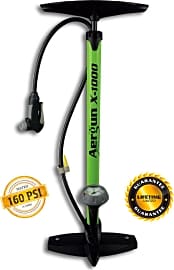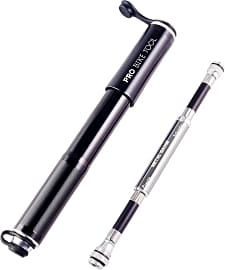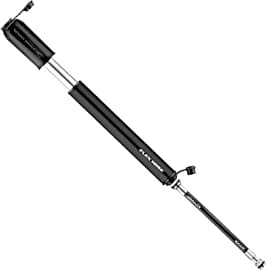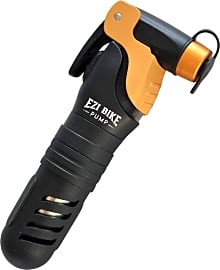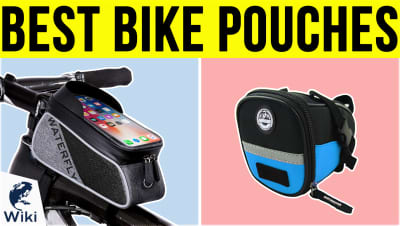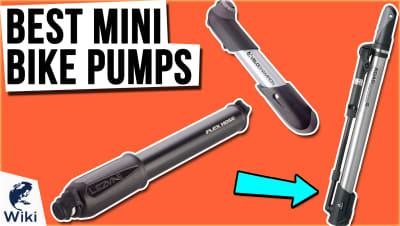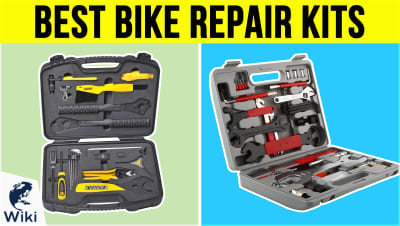The 10 Best Bike Pumps

This wiki has been updated 38 times since it was first published in April of 2015. Bike tires need the proper pressure for both safety and pedaling efficiency. Make filling them easy with one of these bike pumps, which are capable of adding up to 200 PSI to both road and mountain bikes. We've included compact models for taking on the road, as well as sturdier full-size ones that can serve double-duty by inflating sports equipment, air rafts and more. When users buy our independently chosen editorial picks, we may earn commissions to help fund the Wiki.
Editor's Notes
April 05, 2021:
We found most of our previous picks for this list to still be in good standing, but did wind up removing the Birzman Velocity Apogee and Silca Impero Ultimate due to availability issues. We were also disappointed to note that the 15-year warranty that once backed the Vibrelli High Performance had been reduced to five, but we still wound up boosting the option a couple spots on our list, believing that a five-year warranty is still pretty good, and appreciating that this option came with a puncture repair kit.
We thought that the Planet Bike Comp made a nice, new addition to our list. This company’s well known for offering quality equipment at a competitive price, and we also thought that many users shopping in this category would appreciate the interest the brand’s taken in supporting active-transport advocates across the country.
Even though it wasn’t necessarily a perfect fit for this category, we also introduced the Ezi Bike CO2 Inflator low down our list, for the benefit of users looking for an emergency ride-along option. Unlike the manual pumps this list is focused on, this CO2 tire inflator uses compressed air cartridges to get your tires road ready. It’s a lightweight, compact and convenient solution, but the amount of pumping you can do with it will always be limited by the amount of C02 you’ve got in tote, which is its major downfall.
Another option to consider, if you’re highly opposed to manual pumping of any sort, is an electric air pump. Many models in this category are better suited to cars, and intended for use with 12-volt DC adapters, but more and more battery-powered options are coming to market, some with designs compact enough to easily fit inside your panniers.
February 26, 2020:
There are two main types of bike pumps: floor models and portable ones designed for clipping to the frame or carrying in a jersey, hip pack, or bike pounch. Floor models are considerably more powerful, especially well-engineered models like the SKS Rennkompressor, which comes out of Germany and is especially efficient. The Topeak Joe Blow Pro is another high-powered option, although it's also a bit pricey. The Vibrelli High Performance and AerGun X-1000 are excellent choices if you don't want to spend a fortune, and while they're not quite as heavy duty as far as construction and power, they're still great choices. In fact, while they may take a few more strokes than more expensive models, they're both very easy to get on and off valves without leaking air and throwing off inflation levels.
In the middle of the pack in terms of price is the Crankbrothers Gem, which standards apart thanks to an innovative switch that lets you go from high volume pumping at low pressures to high pressure pumping when the tires start to fill, which can speed up the job and save your back and arms a bit. The Lezyne Steel is another impressive mid-range option that ticks many boxes; its durable metal construction means it should last for years and its smooth piston makes for easy inflation.
The other variety, the portable pumps, are quite different. They tend to require quite a bit of work to get tires all the way inflated, and as such are a bit more of a niche item. If you frequently take long treks over the road or in the wilderness, though, you should really consider one; they can be the difference between completing your outing and calling for a ride. We can't go without mentioning the Silca Impero Ultimate, which is both heavy and costly, but is as close in power to a floor pump as you can get at its size. Speaking of size, it and its mounting bracket fit well on most frames and it should never be at risk of getting knocked off.
If you're a mountain biker, the Birzman Velocity Apogee will of particular interest to you. In addition to tires, it can even pump up front suspension shocks, and it's the only one we found with this capability. It's also pretty light, as is the Lezyne Sport Drive. The Pro Bike Tool Mini, meanwhile, stands apart from most frame pumps because it, unlike many others, does have an integrated pressure gauge.
Special Honors
Jenson USA Specialized Air Tool Pro With a 42-inch air hose and 150-PSI maximum pressure rating, this unit sports a cast aluminum construction with an attractive polished finish. It isn't the most affordable option on the market, but is built well enough that you shouldn't need to replace it any time soon, if ever. jensonusa.com
Cycplus A5 This portable, battery-powered unit doubles as a convenient power bank, can handle pressures up to 150 PSI and will stop running after it reaches a preset pressure. It even has a built-in LED flashlight, in case you wind up needing to service a tire after dark. cycplus.com
How Bicycle Pumps Work
When you push down on the handle, the compressed air inside the shaft is then forced out.
A bicycle pump works by pulling in air, compressing it, and then forcing it out and into a tire. All manual bike pumps have a metal or plastic shaft, which is designed to contain the air that is sucked in when you pull the handle upwards. When you push down on the handle, the compressed air inside the shaft is then forced out.
The air exits the shaft and flows through a hose and out of a valve, which is forced open by the pressure of the compressed air. When the handle is pulled up again, the valve automatically shuts so that no air can escape from the tire. Some designs do not have this hose feature but function comparably; it's really for the sake of portability.
The handle that the user is pushing and pulling is attached to a thin rod which enters the shaft's interior chamber. On the end of the rod is a plunger-like assembly that creates an airtight seal against the walls of the shaft. This allows you to completely push all of the air inside of the shaft out when the handle is pushed, and suck in air as you pull back up on the handle.
Bike pumps usually come with either a Schrader or a Presta valve, but some higher end models feature an All Valves Adjustable Connecting System, which can work on both types. Bicycle tire tubes also come with either a Schrader or Presta valve to correspond with the ones found on bike pumps. If you purchase a pump that has a different valve than your bicycle tire tube, you can purchase an AVACS adapter and attach it to your pump. The valves found on bike pumps are designed to lock onto the corresponding valve on the bike tire tube.
Types Of Bike Pumps
Bicycle pumps come in a few different styles. The standard floor pump is what most of us grew up with in our parent's garage or storage closet. They are large, but what they lack in portability, they make up for in speed. Since their shaft is so big, they can move a large amount of air in each pump. They are also easier for kids and those without a lot of arm strength to operate because they allow one to leverage the weight of the body when pumping. They feature a base that the user can stand on while they pump, ensuring the pump sits firmly on the ground and stays in place during pumping. Most also have an integrated pressure gauge, so the user knows exactly when to stop pumping.
Portable pumps come in two different styles; frame-fit pumps and mini pumps.
Portable pumps come in two different styles; frame-fit pumps and mini pumps. A frame-fit pump, as the name implies, snaps directly onto a bicycle's frame without requiring any additional hardware. This is convenient as installation is a breeze, but they must be perfectly sized to your bicycle, otherwise they won't stay securely in place. Frame-fit pumps are heavier and larger than mini pumps, but they also work quicker and can deliver tire pressure up to 160 psi.
Mini pumps are compact enough to fit into a small hydration pack, but most people choose to mount them directly onto their bike frame. Unlike frame-fit pumps, mini pumps do require mounting hardware, but many manufacturers include it with the pump. Mini pumps can achieve from 90 to 160 psi of tire pressure depending on the model.
There are also C02 bike pumps, which don't require any manual pumping. Instead, they use a C02 cartridge, which is capable of delivering enough air to fill a completely empty tire. They can also be used to top off a deflated tire multiple times before being emptied. C02 pumps are the lightest and most compact bike pumps available.
Considerations When Choosing A Bike Pump
Before purchasing any bicycle pump, a cyclist needs to know what type of valve their bicycle tires have. Schrader valves are the most common, but it never hurts to double check. If you are unsure of your bike's valve type and don't know how to check, choose a pump that has an AVACS. You should also consider the materials of the pump's valve head. Metal is more durable and stands up to wear better than plastic, but it is susceptible to rust.
If you are unsure of your bike's valve type and don't know how to check, choose a pump that has an AVACS.
If you're buying a floor pump, check to see how wide the base is. The more stable a floor pump is, the easier it will be to use. Tripod designs are the most stable, while those with just two legs tend to wobble more during pumping. Heavier bases are preferable, as these help your pump stay firmly in place, with less chance of tipping if the gauge is mounted above the center of gravity.
While on the subject of gauges, it is best to buy a pump with a gauge if possible. This will help you accurately determine how much air your tire has. Both over- and under-inflating a tire can cause a range of problems when biking.
Finally, consider how comfortable the handle is. Pumping up a bike tire can take a considerable amount of force and a number of pumps, depending on the size of the shaft. Picking a pump with a comfortable handle will reduce the chance of causing blisters. Look for one with a handle that conforms to the shape of the hand. This will make pumping easier and allow you to inflate your tire more quickly.




